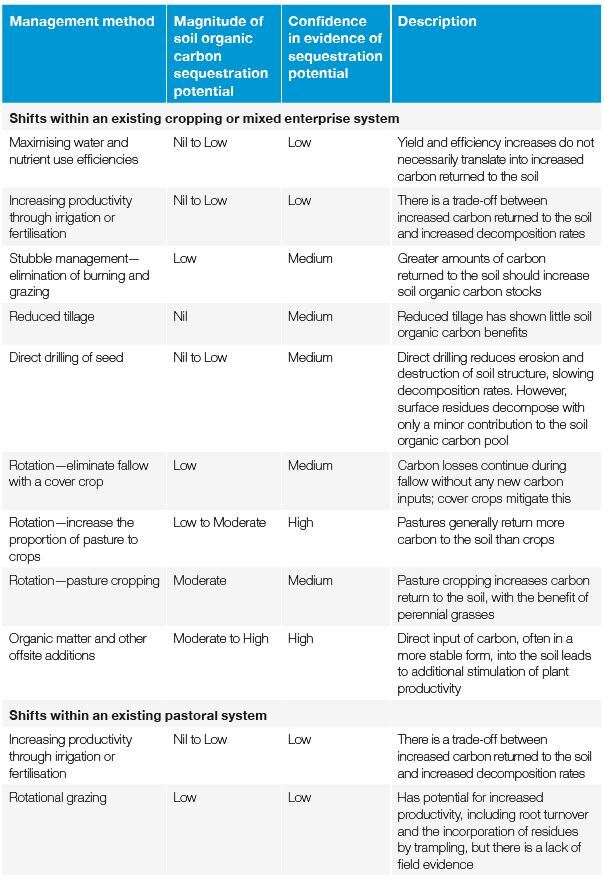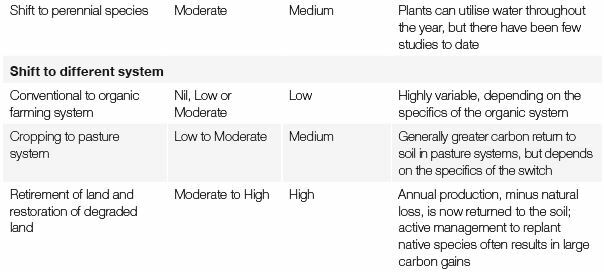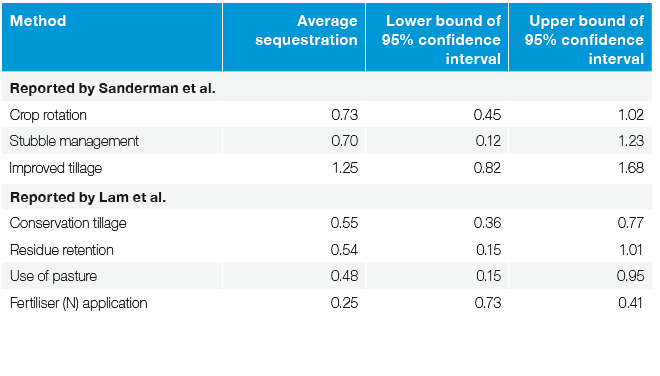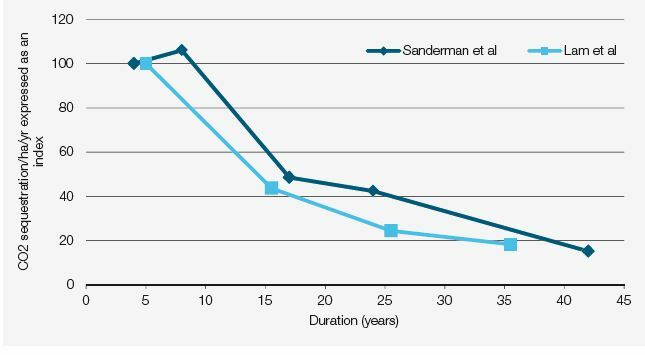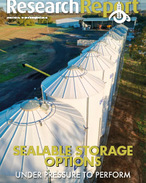8.4.1 Scientific information for soil carbon projects
Most information about the extent to which soil carbon can be increased through agricultural practices comes from detailed analyses of on-farm trials. A number of studies have combined the information from many trials to provide a full picture of sequestration potential*.
Such studies are of particular interest because they provide useful information to incorporate in a business case. They include:
-
Keith Paustian, Sarah Collier, Jeff Baldock, Rachel Burgess, Jeff Creque, Marcia DeLonge, Jennifer Dungait, Ben Ellert, Stefan Frank, Tom Goddard, Bram Govaerts, Mike Grundy, Mark Henning, R. César Izaurralde, Mikuláš Madaras, Brian McConkey, Elizabeth Porzig, Charles Rice, Ross Searle, Nathaniel Seavy, Rastislav Skalsky, William Mulhern & Molly Jahn (2019), Quantifying carbon for agricultural soil management: from the current status toward a global soil information system, Carbon Management Volume 10, 2019 - Issue 6
-
Cécile M. Godde, Peter J. Thorburn, Jody S. Biggs and Elizabeth A. Meier (2016), Understanding the Impacts of Soil, Climate, and Farming Practices on Soil Organic Carbon Sequestration: A Simulation Study in Australia, Agriculture Flagship, CSIRO
-
Sanderman J, Farquharson R and Baldock J (2010), Soil carbon sequestration potential: a review for Australian agriculture, CSIRO Land and Water
-
Lam SK, Chen D, Mosier AR and Roush R (2013), ‘The potential for carbon sequestration in Australian agricultural soils is technically and economically limited' Nature Scientific Reports, 3, article no. 2179
-
Stockmann U, Adams MA, Crawford JW et al. (2013) ‘The knowns, known unknowns and unknowns of sequestration of soil organic carbon', Agriculture, Ecosystems and Environment, 164:80-99
-
Luo Z, Wang E and Sun OJ (2010). ‘Soil carbon change and its responses to agricultural practices in Australian agro-ecosystems: a review and synthesis', Geoderma, 155(3-4):211-223
* Technically speaking, this is known as a ‘meta-analysis'. Essentially, it involves statistically combining and comparing results from different trials.
8.4.2 A qualitative view of the magnitude and confidence of soil carbon sequestration
The study by Sanderman et al. put some effort into understanding both the carbon benefits (that is, the amount of sequestration) and confidence (that is, variability) of particular soil carbon management techniques. Table 8.4 summarises that qualitative assessment.
Table 8.4: Major management options for sequestering carbon in agricultural soils |
|
|
Source: Sanderman J et al. (2010), Soil carbon sequestration potential: a review for Australian agriculture, CSIRO Land and Water
8.4.3 Potential revenue from soil carbon
Table 8.5 summarises potential revenue (per hectare per year) from a range of soil carbon activities for a range of ACCU prices. Note that not all of these practices currently have methodologies associated with them.
Table 8.5: Annual revenue per hectare from first 10 years of
|
|
Source: Derived from Lam et al. (2013), ‘The potential for carbon sequestration in Australian agricultural soils is technically and economically limited' Nature Scientific Reports, 3, article no. 2179
|
8.4.4 Drilling deeper to understand revenue potential
The summary in Table 8.5, while suggesting potential revenues from some activities designed to build up soil carbon, does not fully capture all aspects of soil carbon revenues that are of interest for a business case. In particular, a soil carbon business case needs to drill down further on the revenue side to consider:
-
exactly what forms of carbon increase are recognised in particular ERF methodologies
-
variability in sequestration estimates and in particular the uncertainty attached to particular estimates
-
the extent to which sequestration estimates depend on the soil depth
-
the extent to which sequestration estimates depend on the time frame over which a project is undertaken
-
other specific features associated with particular methodologies.
Each of these points is considered further below.
NOTE: A 2016 research paper titled "Estimating the economic value of soil organic carbon for grains cropping systems in Western Australia", by E. H. Petersen A B D and F. C. Hoyle, found that the marginal value of soil organic carbon (SOC), which is the value of a soil with more SOC, by 1 t C/ha, than a standard soil, was in the range of AU$7.1-8.7/t C.ha.year, depending on rainfall zone and crop type. The authors point out that their results imply this it is unlikely that the SOC benefits will drive practice change in the south-west of WA.
8.4.5 Understanding the measurement of soil carbon changes
Figure 8.1 illustrates three potential soil carbon pathways over time. The first is ‘business as usual' soil carbon stocks, which are shown as declining over time in order to illustrate key points below. (While stocks decline in many parts of Australia, that is not necessarily true in all places.)
The second path follows from the introduction of a new farm practice (in Year 1) that leads to constant soil carbon stocks over time. This is an increase in soil carbon relative to business as usual, but is not an increase relative to Year 1.
The third path also follows from the introduction of a new farm practice in Year 1, this time leading to an increase in soil carbon over time. This increase is not only relative to business as usual, but also to the starting point in Year 1.
If soil carbon is measured again in Year 5 (an illustrative year), there are effectively two sources of the increase in soil carbon relative to business as usual. One of them (A) is the directly measured increase in soil carbon relative to Year 1.
The second (B) is the increase relative to business as usual. This is effectively an ‘avoided' emission of soil carbon (that is, an avoided loss of soil carbon).
Both these sources of gain are legitimate increases in soil carbon that, with appropriate methodologies, could lead to the generation of ACCUs.
However, the existing soil carbon methodology (for sequestering carbon in soils in grazing systems) is a direct measurement methodology and so will only be able to measure amount A; it does not contain specific accounting for declining business-as-usual soil carbon.
The distinction between A and B is crucial, particularly because many of the studies that measure the impact of practices on soil carbon effectively measure both A and B, whereas potential actions under the currently available soil carbon methodology will only be able to achieve A.
It is possible that, despite the fact that analyses of field trials show relative sequestration potential (a slower rate of decline, for example), directly measured sequestration will not show any increase in soil carbon and will therefore not lead to the generation of ACCUs.
This outcome will not be known until actual measurement takes place.
Figure 8.1: Avoided soil emissions versus measured carbon sequestration |
|
|
8.4.6 Variability of soil carbon sequestration estimates
Table 8.6 summarises sequestration results from some of the studies cited above. It
sets out:
-
average annual sequestration
-
the lower bound of a 95% confidence interval from the combined analysis of different trials
-
the upper bound of a 95% confidence interval from the combined analysis of different trials.
The 95% confidence interval is a statistical concept designed to measure the probability that the measurement will fall within a particular range. Statistical analysis suggests that in 95% of cases the measurement will fall between the upper and lower bounds indicated.
Table 8.6: Variation of sequestration estimates (t CO2-e/hectare/year) |
|
|
Sources: Sanderman J et al. (2010), Soil carbon sequestration potential: a review for Australian agriculture, CSIRO Land and Water; Lam SK et al. (2013), ‘The potential for carbon sequestration in Australian agricultural soils is technically and economically limited', Nature Scientific Reports, 3, article no. 2179
A number of features are evident from this table. First, the estimate of average sequestration varies between different datasets, and the Sanderman et al. results generally give higher estimates.
Second, the range of sequestration estimates (as seen in the 95% confidence interval) is very wide. A key implication of this for a business case is that actual sequestration could turn out to be lower (or higher) than the average values observed and often reported.
The lower bound is particularly relevant when considering the downside risk of a soil carbon sequestration project. Note also that, as noted above in the discussion about Figure 8.1, some of the reported increase in soil carbon is in fact a relative increase from an avoided further decline in soil carbon stocks.
Not all of that amount would necessarily be captured in a methodology based on direct measurement.
8.4.7 Sequestration and soil depth
The available scientific evidence clearly indicates that most sequestration occurs close to the soil surface, making sampling depth very important. This is illustrated in Figure 8.2, which summarises findings from both Sanderman et al. and Lam et al.
Because the two studies report different levels of sequestration, the results in the chart are expressed as an index, where 100 is set as the highest level of sequestration for each study. This allows the studies to be compared on the same basis, and indicates that they both have essentially the same result.
The decline in average annual sequestration as measured depth increases is dramatic. Below 10 cm, sequestration rates fall to about 20% of those measured above 10 cm. This has stark implications for a business case: the depth of measurement is crucial.
Figure 8.2: Average annual sequestration and depth |
|
Data source: CIE calculations based on Sanderman J et al. (2010). Soil carbon sequestration potential: a review for Australian agriculture, CSIRO Land and Water; Lam SK et al. (2013), ‘The potential for carbon sequestration in Australian agricultural soils is technically and economically limited', Nature Scientific Reports, 3, article no. 2179 |
8.4.8 Sequestration and time
The scientific evidence also indicates that rates of sequestration decline over time. This is illustrated in Figure 8.3, which shows results from both Sanderman et al. and Lam et al., expressed in index form to allow comparisons. Again, these results are stark: the longer sequestration rates are measured, the lower is average annual sequestration.
After five years, rates fall so that by 15 years they are at most 50% of the rates measured earlier. The rates continue to fall, so that after 20 years sequestration could be as low as onethird of initial estimates.
Figure 8.3: Average annual sequestration and time |
|
Data source: CIE calculations based on Sanderman J et al. (2010), Soil carbon sequestration potential: a review for Australian agriculture, CSIRO Land and Water; Lam SK et al. (2013), ‘The potential for carbon sequestration in Australian agricultural soils is technically and economically limited', Nature Scientific Reports, 3, article no. 2179 |
8.4.9 Available soil carbon methodologies
At the time of publication of this update, two soil carbon sequestration methodologies were open, both under the "Agricultural Methods" section of the ERF:
-
Measurement of soil carbon sequestration in agricultural systems method
-
Estimating sequestration of carbon in soil using default values (model-based soil carbon) method
The "Sequestering carbon in soil in grazing systems" method closed in 2014.
NOTE: The 2015-16 method prioritisation process resulted in an agreement that a new soil carbon method should be developed building on the two existing soil carbon methodologies. The need was identified as there had been limited uptake of the existing soil carbon methods. This outcome was attributed to the narrow range of farming systems that were able to participate and the high costs of direct measurement.
The Carbon Credits (Carbon Farming Initiative—Measurement of Soil Carbon Sequestration in Agricultural Systems) Methodology Determination 2018 sought to overcome these limitations by introducing new components and adapting some components from the two earlier soil carbon methods. The major differences include:
-
an improved soil sampling strategy to reduce uncertainty of soil carbon estimates, supporting the participation of a wider range of production systems;
-
an increased range of eligible farming systems including cropping, grazing and horticultural production systems;
-
allowing the use of soil amendments containing biochar and accounting for other additives that may contain carbon, including clay;
-
an additional measurement option allowing for the ability to estimate carbon stocks using in-field or laboratory sensors and associated models as well as the combustion techniques;
-
a ten year baseline period; and
-
use of a land management strategy, to be developed or reviewed by an independent person.
Source: EXPLANATORY STATEMENT issued by the Authority of the Minister for the Environment and Energy, Carbon Credits (Carbon Farming Initiative) Act 2011, Carbon Credits (Carbon Farming Initiative-Measurement of Soil Carbon Sequestration in Agricultural Systems) Methodology Determination 2018
Explore the full Workshop Manual: The business case for carbon farming: improving your farm’s sustainability (January 2021)
Read the report
RESEARCH REPORTS
1. Introduction: background to the business case
This chapter lays out the basic background and groundwork of the manual
RESEARCH REPORTS
1.2 Being clear about the reasons for participating
Introduction: background to the business case
RESEARCH REPORTS
1.4 Working through the business case for carbon farming
Introduction: background to the business case
RESEARCH REPORTS
1.5 Factors determining project economics
Introduction: background to the business case
RESEARCH REPORTS
1.8 Important features of the business case
Introduction: background to the business case
RESEARCH REPORTS
2. How carbon is farmed under the ERF
This chapter considers in detail the activities that constitute carbon farming
RESEARCH REPORTS
2.5 Carbon farming under the Emissions Reduction Fund
How carbon is farmed under the ERF
RESEARCH REPORTS
3. The policy context and the price of ACCUs
This chapter takes a broad look at the policy context for carbon farming





